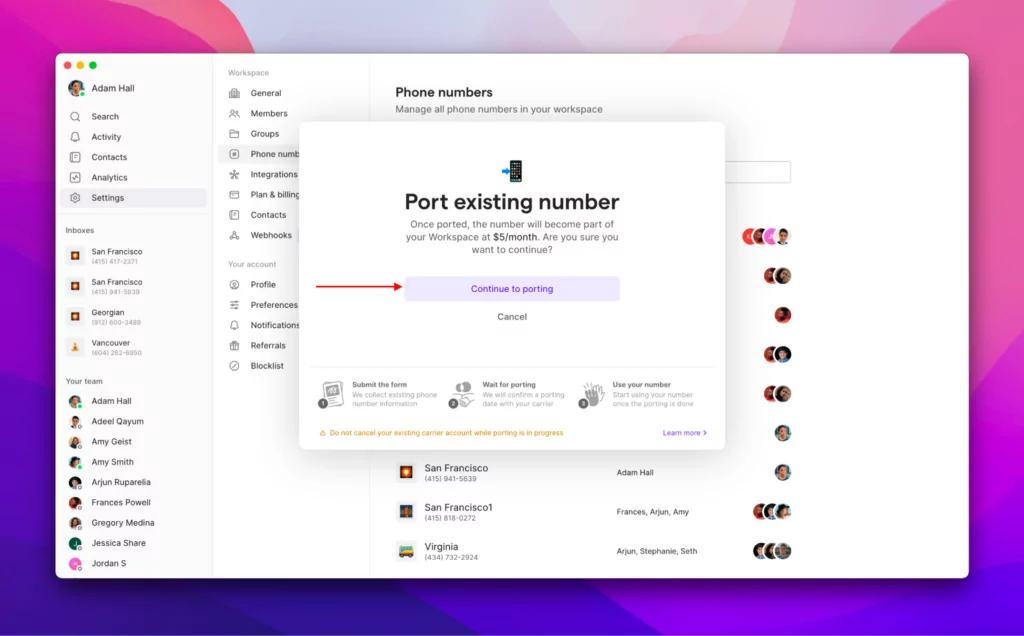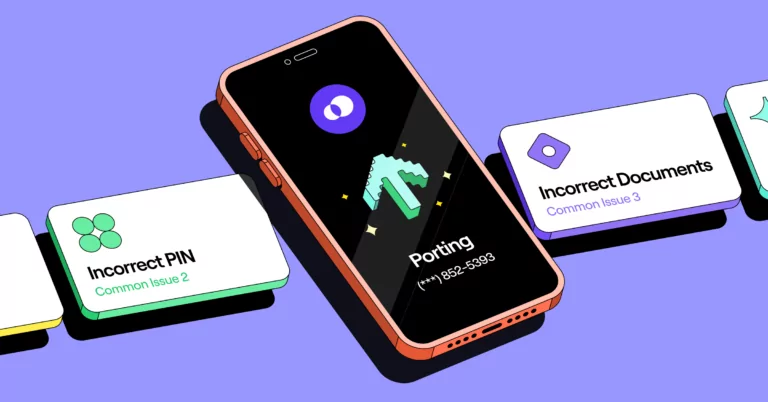In a fast-paced world, moving on to new or different technology should be fast, too. But this is rarely the case for mobile number porting. Porting a mobile number can feel like herding cats — you have to keep your customers informed while juggling requests from your old and new carriers.
Porting an existing phone number to a VoIP provider takes 5-7 business days in the US and 7-10 in Canada. But porting time frames can extend to 12-14 days because of delays and rejections.
Luckily, most complications can be solved. In this article, we help you identify and solve common number porting issues to ensure a smoother transition.
1. Information mismatch
An information mismatch is a discrepancy between the information you provide your current carrier during your port-out request and the one they have on file. If any identifying details have changed — for example, your name, business name, address, account number, account telephone number (ATN), or business telephone number (BTN) — you’ll need to provide documentation to verify the changes.
Solution: To prevent holdups, reach out to your existing provider to confirm the information they have on file for you before making a porting request.
2. Incorrect PIN or password
Some providers may require a port-out PIN or password to authenticate and approve the port. This allows them to verify that an authorized account holder has filed the request. If you have a local US number, you can find your porting/transfer PIN in the account dashboard of your current carrier.
Solution: Contact your current provider about any porting PIN-related questions or to request an updated password.
3. Incorrect or missing documentation
If you haven’t received a confirmation email for your port request, double-check your documentation for these common number porting issues:
- No LOA (Letter of Authorization) provided: The LOA is a mandatory document authorizing the transfer of your phone number. Ensure you’ve filled one out and submitted it according to your new provider’s instructions (usually available on their website or by direct request).
- LOA provided but not signed: An unsigned LOA invalidates your port request.
- No billing receipt provided: Your billing receipt acts as proof of ownership of the number.
- Wrong billing receipt provided: Ensure the billing receipt you provide matches the account and number you’re attempting to port.
- Incorrect phone number listed on the invoice: Verify the phone number listed on your most recent invoice from your current provider matches the number you want to port.
- Invoice information is under another name than LOA: This can happen when the phone number is registered under another business or associate’s name. You’ll need additional documentation like a power of attorney or a company authorization letter to bridge this gap.
Solution: Most phone carriers list porting documents on their website or number porting portals. If you’re not sure where to find them or instructions are unclear, contact your provider for help.
The person listed on the porting request needs to be an authorized account holder. A misunderstanding of account permissions or a change in account management can lead to number porting issues. For example, you might be under a business plan where your manager has administrative control over the number. Your manager would need to authorize the port request independently.
Solution: Check your account status online or contact your service provider to verify you’re listed as an account holder or authorized manager with porting privileges.
5. Delays hearing back from your current provider
In the United States, the Federal Communications Commission (FCC) requires carriers to process simple porting requests — which do not involve more than one line or complex adjustments to telephone switching equipment — within one business day. Despite FCC regulations, some providers don’t prioritize requests because they don’t want you to leave.
Porting from a traditional cell phone carrier to a VoIP provider can take longer — 5-7 business days or more. Porting from a landline can take more time – more than 24 hours to initiate the port and up to 12 business days to complete it. Comparatively, VoIP to VoIP ports — such as Dialpad to OpenPhone — are smoother. Unlike some carriers that charge a porting fee, number porting is free on OpenPhone.
Solution: To stay on track with porting, monitor your timeline to keep your port-in request moving. Account for a delay of 3-4 days, but follow up with your existing carrier if it takes longer.
6. Not receiving an authentication code for Canadian cell numbers
Canadian cell carriers require their customers to respond to an SMS authentication code to schedule a port out. If you don’t receive a text notification, check for common issues such as:
- SMS blocking services activated on your account
- Carrier network issues
- An incorrect phone number
Solution: If you haven’t received your code, follow up with your carrier to request one. You can also check with your current carrier to see if you can set up a call authentication or a pre-approval instead. Some carriers also give you the option to verify via email or a mobile phone app.
7. Not completing carrier registration before porting over
Large US cell carriers are pushing for regulations to reduce the amount of spam their customers receive. If you’re porting to a VoIP solution, you’ll need to register with your provider (you may have seen this referred to as A2P 10DLC registration) before you can send a text from your phone number to any US number.
Solution: If you’re considering porting to OpenPhone, we recommend completing this registration step and waiting for your application to be approved before porting a local US or Canadian phone number to your new provider.
In some cases, though, you may still experience temporary texting delays due to emerging regulations, but registering minimizes that risk since you’ve pre-verified your identity.
8. Disconnected phone number
You can’t port a disconnected, suspended, or inactive phone number. To reactivate your number, contact your losing provider and ask them the reason for the discontinuation — for example, an outstanding balance. Other common reasons for deactivation are inactivity, violation of service terms, or contract termination.
While most service providers offer a grace period to clear balances or resume activity, they also have deadlines after which they can permanently deactivate your number.
Solution: To ensure your number is connected, regularly check your account status during the porting process and notify your provider of any changes in your circumstances, like a period of inactivity or changes in the billing cycle. If you notice your number has been disconnected, request to reactivate it ASAP.
Porting a number is easy with OpenPhone

If you’re porting over from a traditional carrier like Verizon or AT&T, stay on top of your request and follow up quickly if there’s a delay. Traditional carriers often have complex procedures, which may mean additional steps and longer processing times.
Porting a number to OpenPhone is free and easy. After you’ve confirmed OpenPhone is a great fit during a free trial, you can complete your request directly in the OpenPhone web or desktop app.
To get more information on mobile number porting, head over to our guide.
Number porting FAQs
If you experience delays, contact your current and future service providers to confirm the status of your porting request and ensure you’ve submitted all the required documents. Sometimes, missing information or discrepancies cause number porting issues that can be quickly resolved with communication.
You may experience minimal service disruptions during the number porting process. Typically, the actual transfer happens within a short time frame, often outside peak hours, to minimize inconvenience. However, it’s advisable to have an alternative communication method (such as call forwarding) ready if mobile communication is mission critical for you.
You may be able to cancel a number porting request once it’s initiated — it depends on how far you are in the process. Contact your current provider ASAP if you decide to cancel — there might be fees or cancellation deadlines.
Not every number is portable. The ability to port depends on carrier policies and whether or not the prospective provider covers your geographic area. While the FCC requires carriers to allow consumers to switch, double-check with your current and prospective providers to confirm you can port your number.
An outstanding balance can prevent you from porting your phone number. Some carriers have more lenient policies and may allow you to port your number despite unpaid balances, but it’s recommended to contact your provider and settle the amount to avoid additional charges and delays.
Some service providers may charge a fee for porting your number, while others offer this service for free as an incentive to switch. Inquire about potential fees or associated costs with your current and new providers before you initiate the porting process. Porting your number to OpenPhone is free.
To ensure a smooth number porting process, verify the portability of your number with both providers, provide accurate and complete information, and submit any required documentation promptly. Communicate with your current and future providers throughout the process to eliminate number porting issues that may arise.

